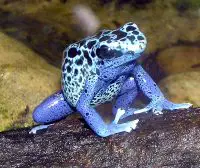Poison dart frog (Dendrobatidae) is the name of a group of brightly colored frogs that belong to the family Dendrobatidae, which contains 170 species of frogs. They are one of the most poisonous species around the world. A golden poison dart frog can kill 20,000 mice from its venom.
The bodies of poison frogs are brightly colored and these colors serve as the “warning signal” for the predators to stay away because of the toxicity of the prey. The brighter the color is, the more toxic it would be. These frogs are found in different bright colors like blue, orange, green, yellow and red.
The adult poison frogs can be as long as 6 centimeters and weigh up to 1 ounce. However, most of them are not more than 1.5 centimeters in length.
 The poison frogs have a lifespan range of 3 to 15 years.
The poison frogs have a lifespan range of 3 to 15 years.
The male frog fertilizes the cluster of eggs when they are laid by the females. The female poison frogs choose their mates on the basis of their coloration and territory.
A female poison frog lays her eggs on soggy areas like plants and leaves. After the hatch, the mother gives the tadpole (larva) a piggyback ride into the pools of water.
The poison frogs are native to the tropical rainforests around the South and Central America. In the South, they are present in states like Bolivia, Brazil, Venezuela and Peru. In the Central America, they are found in states like Panama and Nicaragua.
These frogs occupy habitats of subtropical, tropical and lowland forests, tropical scrublands, freshwater swamplands, lakes and river mouths. Some species are also found in pasturelands, arable fields and tropical grassy plains. The frogs from this family may also live on trees that may be as high as 33 feet above the ground.
The poison frogs are carnivores and their primary diet includes termites, ants and mites. These frogs usually prefer to eat young crickets, fruit flies and small beetles. They capture their prey with the help of their sticky and stretchy tongue.
Other Names: Poison frog, dart-poison frog





